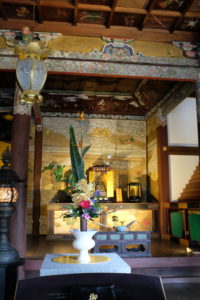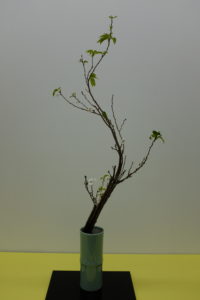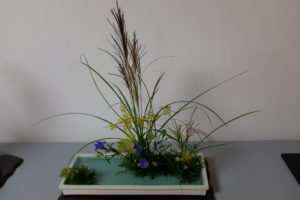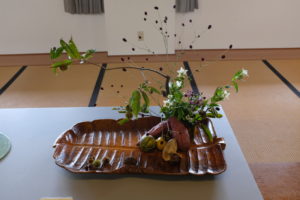The Saga Goryu School of ikebana teaches several styles and categories of arrangements practised by the students of the school. The principal styles of the school include, shogonka, seika, heika, moribana, landscape arrangements and bunjinka. In addition to these styles, there is a modern category of arrangements called shinshoka, that seeks to apply the classical philosophy and principles of the Saga school to the new materials and surroundings of the modern era. Below will be short descriptions of each of the principal categories of arrangement.
Shogonka

The Shogonka arrangement style is derived from ancient altar arrangements created in the temples and palaces onto the altars of the Buddha. The principles of this arrangement are based onto the esoteric buddhist rokudai philosophy, and the arrangements convey a sense of great formality and solemnity. The arrangements are gradified into formal, semi-formal and informal styles, which in turn each break into three further sub grades.
Seika

The Seika style was developed to decorate the tokonoma or the alcove of private houses, and it expresses the relationship of Heaven, Earth and Man in symbolic form. Using fewer branches and materials than the grand shogonka, it became a style accessible to more people than the shogonka of before. The seika style is also divided into three degrees and three sub degrees of formality.

Heika
The Heika style features arrangements done in upright containers, arranged with greater freedom and naturalness than the two previously described styles. It’s prescribed techniques and proportions strive for the so-called nageire (lit. “thrown-in”) look to convey a feel of ease and casualness. The arrangements within this category are further classified according to the positions of the main branches.
Moribana

The Moribana style is a style of arrangement created in shallow containers emphasising the surface of water that is visible and a vital part of the arrangement. The image conveyed is a natural and fresh with seasonal lushness. The arrangements are classified according to the angles of the main branches.
Landscape arrangements

There are 7 natural landscape arrangements and 3 scenic landscape arrangements in the Saga school. The seven natural landscapes capture the essence of natural spots such as mountain, field, pond or field surroundings. The three scenic styles convey the feeling of classical scenic spots found around the Daikaku-ji temple, namely those of Teiko, Arashiyama and Takao. Teiko is famous for its autumn chrysanthemums the scene located in the Daikaku-ji temple itself in the islands of Osawa Pond created by Emperor Saga. Arashiyama is known for its splendid cherry blossoms and Takao for the red leaves of autumn.
Bunjinka

Bunjinka (also known as bunjinbana) is a style of flower arrangement born in the Edo period, favoured by the literati of the time. Drawing inspiration from classical Chinese literature, poetry and painting, it seeks to convey a poetic or seasonal athmosphere, or the feelings of the arranger. Bunjinka are arranged in a very free manner, and complementary items such as fruits, vegetables, stones and small items may be added to complete the work.

Shinshoka
The Shinshoka are arrangements that abbreviate the classical styles for modern purposes. They are namely the sainohana, which is the abbreviation of Seika, the omoibana, which is the abbreviation of moribana, and the funinohana, kusonohana and the inoribana, which each are abbreviated forms of the shogonka.
